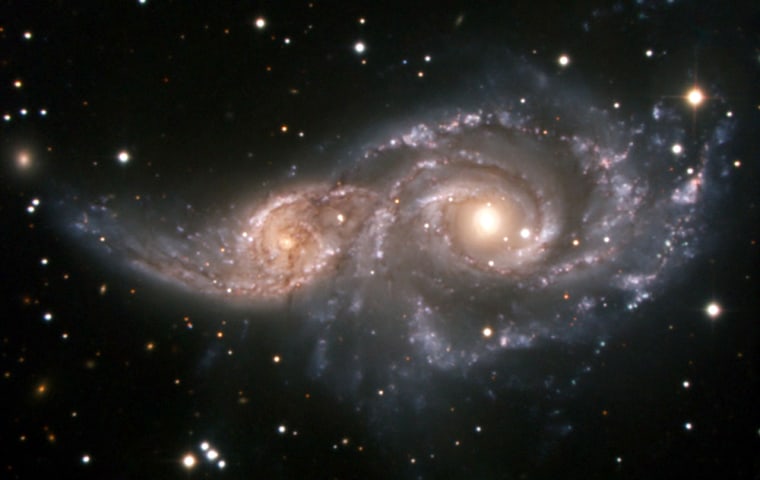Enormous black holes, some of the most powerful sources of radiation in the universe, apparently switch on after galaxies collide, researchers have found.
The centers of as many as a tenth of all galaxies generate more energy than can be explained by stars, with some of these "active galactic nuclei" releasing more radiation than the entire Milky Way galaxy combined, but from a space no larger than our solar system. Astronomers suspect this energy is released when matter falls into giant, supermassive black holes that are up to billions of times the mass of our sun at these galaxies' cores.
"These monster black holes evolve in a way that is strongly related to the amount of dark matter that surrounds them and that is intimately related to the probability of galaxies to merge," said study lead author Nico Cappelluti, an astrophysicist at the Max Planck Institute for Extraterrestrial Physics in Garching, Germany.
The new study supports the idea that these active galactic nuclei are stimulated when two galaxies are drawn together by their mutual gravitational attraction and ultimately merge to become one. The process likely shakes up matter and pushes material toward the center of the new mega-galaxy, creating a perfect feeding ground for a hungry black hole.
This concept has been proposed before, but the new research provides further observational evidence that this is the case. (Photos: When galaxies collide.)
Black hole power activate!
To study these active galactic nuclei, researchers analyzed 199 galaxies.
They relied on hard X-ray data from NASA's Swift spacecraft, which provided unprecedented depth and details about X-ray sources, Cappelluti said. Previous studies investigated active galaxies based on optical or soft X-ray emissions, which miss a major part of the radiation generated by galaxies' central black holes.
The black holes powering these active galactic nuclei were typically about 300 million solar masses in size — roughly 75 times that of the black hole at the Milky Way's core. Their galaxies were usually about 200 billion solar masses in size, residing in huge bubbles of dark matter 100 times as massive as the entire Milky Way.
Galaxy collision culprit
By combining this observational data with theoretical predictions, the scientists found the most plausible scenario for the origin of these active galactic nuclei involved galaxy collisions.
"We find it very exciting how the results of our data analysis match the prediction of computer simulations that assume that the black holes are switched on by galaxy mergers," Cappelluti told SPACE.com.
The active galactic nuclei appear to switch on roughly 700 million years after two galaxies collide and merge "and shine brightly for the first part of their lives, where they gain most of their mass," he explained.
After roughly 200 to 500 million years, matter accretes onto the black holes with lower and lower efficiency, essentially starving the black holes as the gas reservoirs around them become depleted.
"Today, they have grown to super-massive black holes with 100 to 1,000 million solar masses and shine with moderately low luminosity compared to other active galaxies," Cappelluti said.
In the future, the researchers would like to see what relationship might exist between the energy output of an active galactic nucleus and the mass of the dark matter bubble in which it lives.
The scientists detailed their findings in a paper to be published in an upcoming issue of The Astrophysical Journal.
